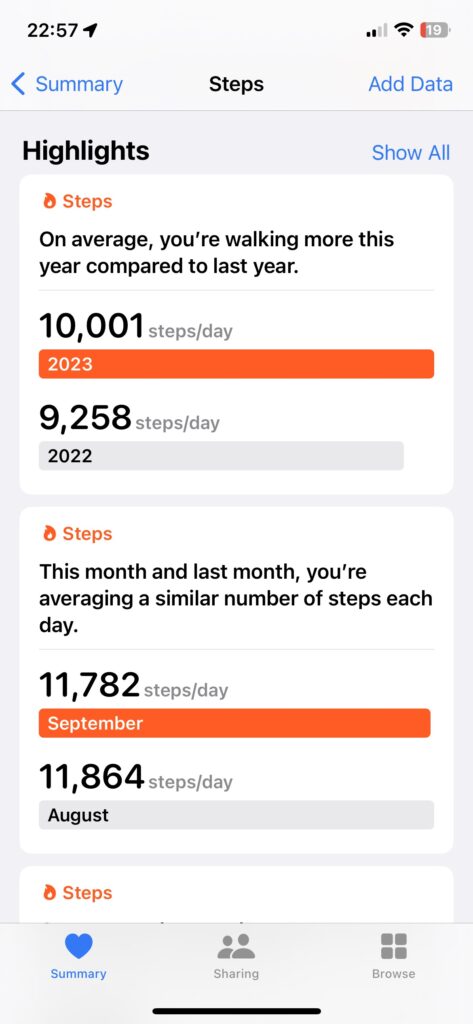Table of Contents
In today’s fast-paced world, staying active and maintaining a healthy lifestyle has become more important than ever. One popular fitness trend that has gained significant attention is the concept of walking 10,000 steps a day. But what exactly happens to your body when you commit to this daily step count, and is it enough to achieve your fitness goals? In this comprehensive blog post, we’ll explore everything you need to know about walking 10,000 steps a day.
1. What Happens to Your Body When You Walk 10,000 Steps
Walking is a low-impact exercise that offers a wide range of benefits for both your physical and mental well-being. When you commit to walking 10,000 steps a day, here’s what happens to your body:
A. Improved Cardiovascular Health
Walking is an excellent way to improve your heart health. It strengthens your heart, lowers blood pressure, and reduces the risk of cardiovascular diseases.
B. Weight Management
Regular walking can help you maintain or even lose weight. When you walk 10,000 steps a day, you burn calories and increase your metabolism.
C. Enhanced Mental Well-being
Walking outdoors can reduce stress, anxiety, and depression. The fresh air and physical activity release endorphins, improving your mood.
D. Stronger Muscles and Bones
Walking engages various muscle groups, improving muscle strength and bone density. This can help prevent osteoporosis and reduce the risk of injuries. Read more about muscle growth with clenbuterol.
E. Better Digestion
Walking aids in digestion and can alleviate common digestive problems. It promotes the movement of food through the digestive tract.
2. Guide on How to Start
Starting a daily walking routine is easy, but it’s essential to do it correctly to avoid injury and ensure long-term success. Here’s a step-by-step guide:
A. Invest in Comfortable Footwear
Choose comfortable, supportive shoes to reduce the risk of blisters or foot pain.
B. Set Realistic Goals
If 10,000 steps seem daunting, start with a lower step count and gradually increase it over time.
C. Create a Routine
Set aside a specific time for your daily walk. Consistency is key to building a habit.
D. Mix Up Your Routes
Exploring different routes can keep your walks interesting and motivate you to continue.
E. Stay Hydrated
Bring a water bottle with you to stay hydrated during your walks, especially in hot weather.
3. How Many Calories Will You Burn by Walking 10,000 Steps
One of the most common questions about walking 10,000 steps a day is how many calories it burns. The exact number depends on factors like your weight, walking speed, and terrain. On average, a person weighing around 155 pounds can burn approximately 314 calories by walking 10,000 steps at a moderate pace.
4. Is Doing 10,000 Steps a Day Enough to Lose Weight?
Walking 10,000 steps a day can certainly aid in weight management and may lead to weight loss, especially if combined with a balanced diet. However, whether it’s enough to solely rely on walking for weight loss depends on your individual goals and calorie intake. To shed pounds effectively, a combination of regular exercise and a calorie-controlled diet is often recommended. Did you know that Clenbuterol could be your secret weapon for weight loss? Here’s how.
5. Have a Yearly Goal to Average 10,000 Steps a Day
Consistency is key when it comes to maintaining a healthy lifestyle. Instead of setting short-term goals, consider making it a yearly commitment to average 10,000 steps a day. This approach helps ensure that walking remains a part of your daily routine in the long run, leading to lasting health benefits.
6. The Pros and Cons of Walking 10000 Steps a Day
As with any fitness regimen, there are pros and cons to walking 10,000 steps a day:
Pros:
1. Accessibility
Walking requires no special equipment, making it accessible to almost everyone.
2. Low Impact
It’s a low-impact exercise, reducing the risk of injuries compared to high-impact activities.
3. Mental Health Benefits
Walking outdoors can have a positive impact on mental health, reducing stress and improving mood.
Cons:
1. Time-Consuming
Walking 10,000 steps a day can be time-consuming, especially for those with busy schedules.
2. Limited Intensity
While walking is great for overall health, it may not provide the intensity needed for specific fitness goals.
3. Weather Dependence
Inclement weather can hinder daily walking routines, making it challenging to reach your step goal.
Final Verdict!
In conclusion, walking 10,000 steps a day can be a fantastic way to improve your health and well-being. It offers numerous benefits, from better cardiovascular health to enhanced mental well-being. However, it’s essential to remember that it’s just one piece of the fitness puzzle. To achieve comprehensive health and fitness goals, consider combining regular walking with a balanced diet and other forms of exercise tailored to your specific needs and objectives. Here’s an in-depth post on how to stay fit and healthy with clenbuterol.







